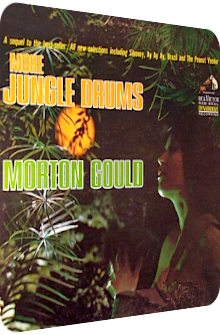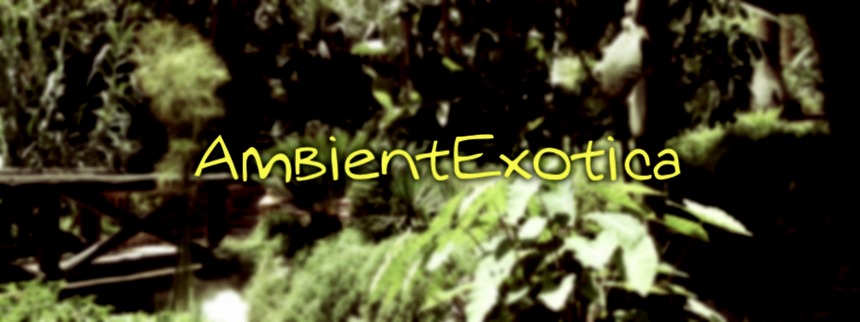
Morton Gould
More Jungle Drums
1964
If I was forced to be utterly sarcastic, I would dish up the following question in befuddlement: why is conductor and arranger Morton Gould's (1913–1996) LP called More Jungle Drums? Its predecessor from 1957, called Jungle Drums, did not even feature one single bongo, conga, djembe or goblet drum, so we all know what happens when one multiplies nullity with nonentity, right? Anyway, enough of the hate, for the original Jungle Drums not only had its moments, it was in fact a genuine work of commercial and aesthetics-related success! Having been conducted very shortly after the sudden rise of the genre which was kicked off by Martin Denny's Exotica in early 1957, its whopping amount of 15 compositions lured the listener with a comprehensive suite of material by Ernesto Lecuona on side A and became even more exotic and phantasmagoric on side B. Vigorous strings, the verdure of flutes and the exoticism of many other instruments were included… but there was one glaring omission: the titular jungle drums! The reason is easy to denominate, for Jungle Drums is rooted in the classically symphonic scheme of those days. Only after the success of Exotica quartets or related Jazz bands was there a shift taking place to include colorful percussion instruments in orchestral setups as well.
In this regard, Morton Gould's More Jungle Drums, released in 1964 on RCA Victor, must deliver shedloads of percussion devices, for 1964 already marked the sunset phase, the calcination of the Exotica genre, and Gould has had plenty of symphonic works to dissect and draw inspiration from. Unfortunately though, at least in this particular regard, More Jungle Drums is an adamant continuation of the '57 formula as if both albums were recorded in one go. It is as if the timespan of seven years between both LP's never existed! And yet are there short appearances of bongos and congas, but they are used far too sporadically next to the lush strings, vivid brass fanfares and effervescent flutes in the given prospect of the album title. So it is once again the melodies and arrangements that have to camouflage the missing main ingredient in addition to another Lecuona suite which happens to be included on side B this time.
Pascual Marquina Narro's melodramatic and flourish-friendly España Cañí opens the junglescape. The world-famous torero fanfare is realized with whirling strings and dusky horn eruptions, whereas the quieter passages are surprisingly fissured and consist of mellow harp sprinkles, a faux-Oriental clarinet melody and the mandatory castanets. The tone sequences spiral upwards to mountainous heights. No exotic percussion devices are found, only double bass blebs and fizzling tambourins are unleashed. Moisés Simon's The Peanut Vendor then launches with mystified legato strings and – shiver me timbers – a stream of bongo droplets plus claves. The rather dissonant opening phase with Space-Age trumpet shards then turns into a mellifluous syrup of pizzicato strings, sun-soaked brass instruments and a gorgeously mellow guitar aorta. The tune is unfortunately too jumpy in its use of the manifold textures and lacks cohesion, but in its best moments, The Peanut Vendor gleams in iridescent colors.
Up next is Morton Gould's own Calypso Souvenir, a Trinidad-flavored piece loaded with turquoise-tinted marimba driblets, prominent bongos and congas, gleeful flutes and mild horns. The middle section includes string washes that are bit too romantic, but there is no need to complain, for the decay of the scattered bongos and congas reverberates deliciously in front of the fissure-laden backdrop. The next tune, Ary Barroso's Brazil, has that carefree Sunday feeling and is a superb rendition that embraces the listener as well as the whole world. Every instrument is utterly silky, the cascading and protuberant strings, flutes and brass sections encapsulate a wideness and harmony that is close to the Easy Listening formula, but I cannot help it, the strings are just too enchanting and carry the whole arrangement. Side A closes with Osmán Pérez Freire's Ay, Ay, Ay which is curiously enough all too string-focused. The solemn prelude is majestic but unfitting, only in the second third does the liveliness increase with pumping timpani and smashing horns before an enigmatic segue of contemplation and shadiness leads to the rapid-firing crescendo complete with a maelstrom of strings and warmhearted trumpets.
Side B is solely dedicated to Ernesto Lecuona in the same way side A of Jungle Drums has been. Siboney kicks off the setting, features an eclectic thicket of pastel-colored horns, a curiously indifferent mood and a short-lived bongo placenta. After almost two minutes, the arrangement opens up like a sunburst with amicable melodies which are then reciprocated with staccato horns and quieter sections. The centerpiece Danzas Afro-Cubanas is next, a suite of eleven and a half minutes spanning four different tunes: La Conga De Media Noche lives up to the name and features the eponymous congas of a wonky kind next to snake-like maracas and refreshingly dubious melodies, with the following Danza Negra being a harmoniously streamlined artifact of benignance with bubbling xylophones, conga blebs, wooden whiplash sounds and majestic strings. No shadow ever appears, making Danza Negra a glowing ditty. Y
La Negra Bailaba! then presents a festive gallimaufry of pointillistic flutes as well as aqueous brass-and-string strata full of joy and happiness, with the final piece of the suite, Danza De Los Ñáñigos, succeeding with dripping claves, fairy tale clarinets and Chinese gongs which lead to the conclusion, namely superb brass eruptions of the Hollywood-esque kind. And so ends a suite of sunny timbre, carefreeness and joy of life. The final two pieces from Ernesto Lecuona's feather are Guadalquivir, taken from his Andalucía suite. Being chock-full of sunset-colored horns and their darker, more spectacular brethren in adjacency to plinking tambourins plus string undulations, it is the album's murky piece, with the final offering In 3/4 Time, taken from his Danzas Cubanas suite, sees Morton Gould changing the style decidedly with a soundscape supercharged with aquatic ingredients such as marimba glints, harp glitters and Balkan-oid oompa brass scents. The thickness of the layers interpolates the pompousness, More Jungle Drums ends on a bright, less melodramatic and well-balanced note.
The original Jungle Drums from 1957 was clearly rooted in the commonplace Easy Listening scheme of orchestral works. Similar to its stylistic next of kin, Andre Kostelanetz' Lure Of The Tropics (1954), Morton Gould carved out the melodies and was less keen on the percussion instruments. The result is vivacious and imaginative to this day, with many bubbling segues and creative improvisations. However, the same averments cannot be applied to More Jungle Drums anymore, not if one takes its music-related historical surroundings into account. After a whopping seven years, Gould relies on the same old shtick; a euphonious, melodious shtick it is, I have to admit, but considering its year of release, it is amazingly retrogressive even for a symphonic Exotica record! There are no excuses anymore, not after the flood of various albums with the marker Percussion in their titles.
Gould could have unleashed a wealth of percussion instruments, but simply does not deliver in this regard, notwithstanding all the good reasons that are washed ashore in hindsight. This omission becomes all the more apparent and appalling if one distills the two distinct meanings of the title: Gould wants to offer jungle drums. He fails. But wait, it gets worse: he wants to offer more jungle drums than ever before. This does not work out all too well either. Only on his own composition Calypso Souvenir and the Danzas Afro-Cubanas suite does Gould inject lots of bongos and congas, but otherwise, they are scattered and rarely used. More Jungle Drums therefore wears the twofold stigma of a lackluster addendum (without a Roman numeral in this case) and the failed promise of its title.
These things being said, with all the negativity and dubiously raised brows during this review's penultimate paragraph, mildness shall reign: if one is willed to look over these obvious flaws, the album is surprisingly rewarding when it is consumed from a positive angle. Since it is so closely tied to its predecessor Jungle Drums, it offers more of the same. Taken out of the historical context and viewed in isolation, this is no bad thing at all! From the bongo-accentuated flamboyant fanfares of The Peanut Vendor over the eternal exhilaration that is Ary Barroso's Brazil to Lecuona's polylayered suite Danzas Afro-Cubanas, Morton Gould transfigures the Latinisms of these classics into technicolor symphonies comprising of reeds, horns and strings. The wealth – cavalcade even – of textures, surfaces and patterns make it an orchestral work that bursts at the seams, especially so if it is compared to the humble beginnings of each composition which was once envisioned on a piano, the formulaic origin to unite them all, and then played in the streets of Cuba and other Latin American countries.
Gould's second jungle-related album is a fitting foil to the original incarnation and readily available in vinyl form, but unfortunately not yet in a dedicated digital download version. Maybe when its 50th anniversary is nigh in 2014, the situation will improve. More Jungle Drums is recommended to those listeners who are fond of the first entry and do not mind the omnipresence of their everyday timpani and kettle drums instead of the more colorful exotic brethren. It is the melodies and the textures that are the kings here. If you are d'accord with this and love symphonic works, More Jungle Drums will suit your needs and successfully hide its flaws.
Exotica Review 216: Morton Gould – More Jungle Drums (1964). Originally published on May 18, 2013 at AmbientExotica.com.
